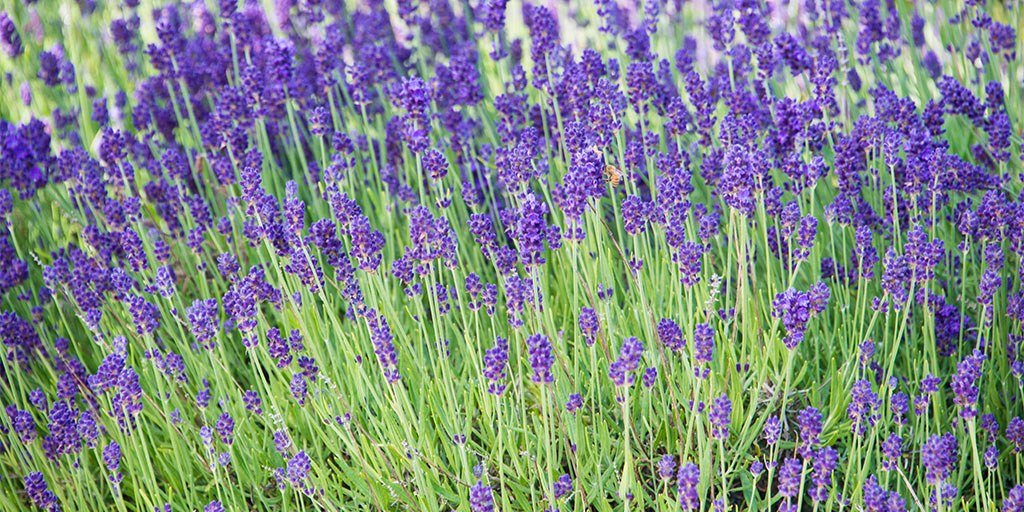Lavender is one of those perennials that checks all the boxes. This low-growing, shrub like plant is versatile in the garden and container friendly; it attracts pollinators and is deer resistant; its fragrant flower spikes brighten the vase and also can be dried for potpourri; and it has culinary uses, too. From the Mediterranean region, lavender has a long bloom time, flowering from midsummer to fall. Its flowers symbolize tranquility, calmness and relaxation.
Often grown in herb and perennial gardens, massed or planted as hedging near walkways, lavender performs best in sunny areas with lower humidity. Most lavender plants grow well in zones 4-9, but there is some variation, depending on the variety. If ingested, lavender can be toxic to cats and dogs. Shop our hardy lavender plants and follow the guide below to ensure healthy growth, or browse our other gorgeous sun perennials.
Types of Lavender Plants
Gardeners can choose from several types of lavender. Some popular lavender varieties include:
- Hardy Lavender: Also called English lavender, this popular variety grows 15-20 inches tall and has very fragrant purple flower spikes. One of the best for drying and culinary uses, it grows in zones 4-9.
- Phenomenal™ Lavender: Newer variety is taller than many others, making it a good choice for hedging. Grows 24-30 inches tall, with very fragrant flower spikes, and is suitable for zones 4-9.
- Sensational® Lavender: A modern take on traditional lavender, it features unusually large flower heads. Growing 22-24 inches tall, it’s suitable for zones 5-9.
Where & When to Plant Lavender
Lavender grows best in full sun and well-drained, sandy soil that is dry to medium. It prefers neutral to slightly alkaline soils. If planting in clay soil, make sure to mix in plenty of compost to improve drainage.
If you don’t have the right soil type, lavender can also be grown in containers. Growing lavender in containers also enables you to move it to a sunny location. If your area is too shaded, then consider browsing our collection of shade perennials.
Lavender can be planted in the spring or the fall. When planting lavender, keep in mind that the plants will grow larger with time and make sure to space them 2-4 ft. apart.
Growing Lavender from Seed
While lavender can be started from seed, most gardeners buy lavender plants and transplant them to the garden. Lavender seed is slow to germinate, often taking 2-4 weeks and sometimes longer. The plants take a while to establish themselves and grow to the transplant stage.
How to Care for Lavender Plants
Once established, lavender is drought-tolerant and fairly trouble free. During the first year after planting, water regularly. However, don’t overwater—as that can lead to fungal and other diseases. In areas with higher humidity, make sure the plants have plenty of air circulation. In the winter, lavender plants benefit from some protection from harsh winter winds. A layer of mulch can protect the roots.
Lavender can thrive in poorer soils and isn’t a heavy feeder. Usually mixing compost into the soil at planting time provides lavender with the nutrients it needs.
Pruning lavender keeps the plants from getting too leggy. In warmer climates, prune in the fall. In cooler climates, prune in the spring.
When & How to Harvest Lavender
The best time to harvest lavender for drying and use in sachets or potpourri is when the flower buds have formed but aren’t completely open. Cut the flower spikes and tie the stems into bundles. Hang the bundles in a dry, warm area away from sunlight and allow them to dry. Once dry, shake the flowers off the stems. Lavender can be stored in a lidded jar or made into sachets or potpourri.
If harvesting the flowers for use in lavender oil, harvest in late spring to early summer before the flower buds open. The fragrance is more intense at this stage.
How to Propagate Lavender
Because it doesn’t handle being divided that well, lavender is often propagated through cuttings. If propagating in the spring, take cuttings from the soft, flexible tips. If propagating in the fall, take cuttings from the hardwood. Cuttings should be taken below a leaf node. Another way to propagate lavender is by layering—or starting with a living stem that is attached to the plant, bending it and placing it in the ground. This process usually takes about a year. Lavender can also self-seed.
FAQs
- How long can lavender plants live?
Lavender is not a long-lived perennial. Depending on its location and growing conditions, a lavender plant can live 5-15 years. - How tall does lavender grow?
Most lavender grows 24-30 inches tall, depending on the variety and the growing conditions. - Why won’t my lavender bloom?
The main causes for lavender not blooming are too fertile of soil, not enough sunlight, overwatering and over pruning. - What are common pests and diseases associated with lavender?
While lavender has few disease or pest problems, some fungal diseases and root rot can be a problem if grown in too humid or too moist conditions.

